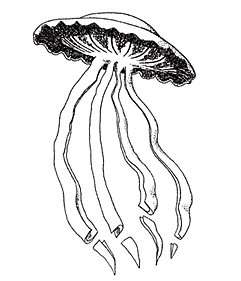Stygiomedusa
Stygiomedusa is a genus of giant deep sea jellyfish in the family Ulmaridae.[2] It is monotypic with a single species, Stygiomedusa gigantea. With only 115 sightings in the last 110 years, it is a jellyfish that is rarely seen, but believed to be widespread throughout the world.[3] It is thought to be one of the largest invertebrate predators in the deep sea ecosystem.[4]
| Stygiomedusa | |
|---|---|
 | |
| Illustration of Stygiomedusa gigantea | |
| Scientific classification | |
| Kingdom: | Animalia |
| Phylum: | Cnidaria |
| Class: | Scyphozoa |
| Order: | Semaeostomeae |
| Family: | Ulmaridae |
| Genus: | Stygiomedusa |
| Species: | S. gigantea |
| Binomial name | |
| Stygiomedusa gigantea (Browne, 1910)[1] | |
| Synonyms | |
| |
The jellyfish has an umbrella-shaped bell that can be up to a metre wide. It also has four "paddle-like" arms up to 10 metres long, which, as they lack stinging tentacles, may be used instead to trap prey.[4] Giant Stygiomedusa have been observed and filmed off the Pacific coast of the United States by scientists and by ROVs off the coast of Japan and in the Gulf of Mexico.[4][5]
Evidence has been reported of a symbiotic relationship existing between Stygiomedusa gigantea and Thalassobathia pelagica, a species of ophidiiform fish.[6]
References
- "Marine Species Identification Portal : Stygiomedusa gigantea". Species-identification.org. Retrieved 2015-08-19.
- Brown, Edward T. (1907). "Coelentera". In Bell, Jeffrey (ed.). Natural History: Voyage of the S.S. Discovery under Capt. R.F. Scott. Zoology and Botany. 5. Biodiversity Heritage Library. p. 57. doi:10.5962/bhl.title.18281. OCLC 727233164. Retrieved 2015-08-19.
- "Giant deep sea jellyfish filmed". 2010-04-23. Retrieved 2019-03-17.
- Bourton, Jody (2010-04-23). "BBC - Earth News - Giant deep sea jellyfish filmed in Gulf of Mexico". BBC News. Retrieved 2010-07-08.
- O'Neill, Kara (2015-08-19). "Mysterious alien-like creature spotted in this deep sea footage - but what is it?". Daily Mirror. Retrieved 2015-08-19.
- Drazen, Jeffrey C.; Robison, Bruce H. (2004). "Direct observations of the association between a deep-sea fish and a giant scyphomedusa". Marine and Freshwater Behaviour and Physiology. 37 (3): 209–214. doi:10.1080/10236240400006190.